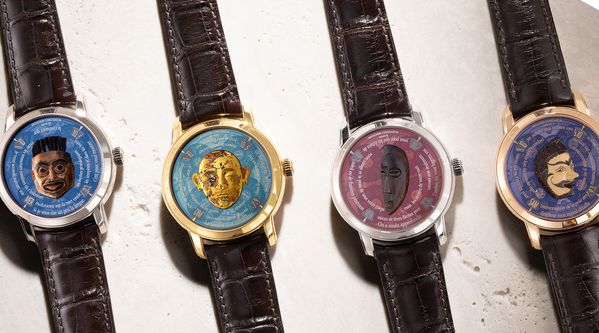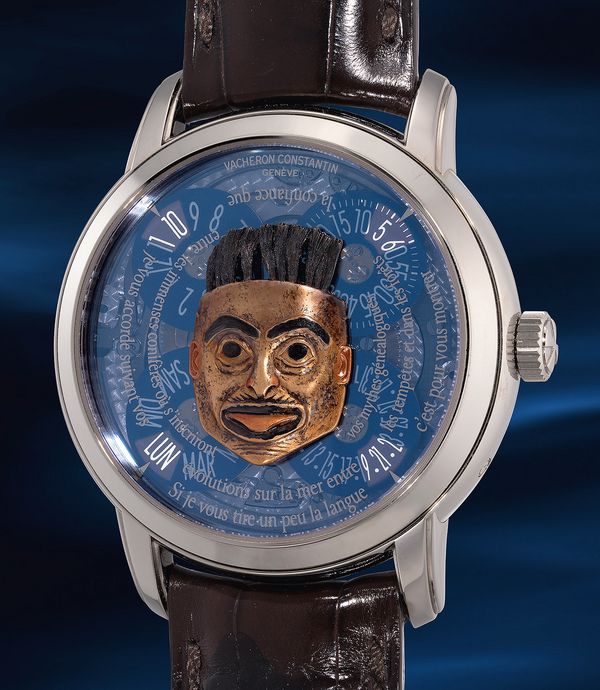The Métiers d’Art “Les Masques” collection by Vacheron Constantin stands as a unique fusion of cultural homage and high horology, exemplifying the Geneva-based brand's dedication to celebrating the artistry of time.
Created in collaboration with the Barbier-Mueller Museum of Geneva, known for its extensive collection of primitive art, this series features 12 miniature mask sculptures crafted from gold and modeled after ancient artifacts representing African, Asian, Oceanic, and American cultures. Each mask appears to float within the dial, framed by tinted sapphire glass that emphasizes its delicate colors and intricate details.
A key feature of the “Les Masques” collection is the Calibre 2460G4, a signature Vacheron Constantin movement that removes traditional hands in favor of rotating discs displaying hours, minutes, day, and date. This design allows the central area to remain uncluttered, creating a striking showcase for the masks.
The sophisticated construction of the movement, along with the watch's transparency effects, illustrates Vacheron Constantin's commitment to pushing the boundaries of watchmaking and artistry. By applying unique metallization processes, the masks are given an ethereal quality that appears to bring these ancient cultural symbols to life.
Moreover, each timepiece is further personalized with inscriptions by Michel Butor, whose poetic prose is engraved in a spiral pattern on the dial. This lyrical element, only visible under certain lighting, creates a meditative depth that enriches the timepiece with cultural reverence.
Produced in sets of four annually from 2007 to 2009, the “Les Masques” collection was limited to just 300 pieces, underscoring its rarity and significance within the luxury watch market. This limited-edition series serves not only as a celebration of fine watchmaking but also as a tribute to the legacy of cultural preservation and artistry.
The above timepiece features a micro-sculpture of an Indonesian Wayang Topeng antique mask from the collection. Wayang Topeng refers to the historical theatrical art form from Bali, a drama of masked dance, music, mime and comedy mostly based on the stories of the Panji-cycle, which is a collection of Javanese stories revolving around the legendary Prince Panji and Princess Kirana. The facial feature on the mask bears a striking resemblance to Prince Panji, with the embroidered headcloth, curling moustache and high eyebrows.
Tilting the watch sideways would reveal shimmering golden letters encircling the dial, piecing together a French poem written by Michel Butor, a celebrated poet who was awarded the Grand Prix de Littérature de l'Académie française in 2013. Dedicated specifically to this timepiece, it masterfully depicts the tantalizing desire found on the facial expression of the mask.
Loosely translated, the poem reads,
“Enjôleur mon regard détaille les formes des filles qui passent mes sourcils sont comme un oiseau qui va s’envoler pour tourner autour de sa proie mes moustaches comme des serpents préparés à bondir lors du moindre signe de faiblesse ou d’acquiescement”
(My beguiling gaze details the shapes of the girls who pass by my eyebrows are like a bird that is about to fly away to circle around its prey my moustache like snakes prepared to pounce at the slightest sign of weakness or acquiescence.)
Not just any random African mask, the above watch features the unique Masque Mahongwé-Ngaré from the Republic of the Congo acquired by Monique and Jean-Paul Barbier-Mueller in May 1984 and was recently sold at auction in 2024 for a stunning result of 4,154,000 Euro. Taking a deep dive into the history and provenance of this intriguing Mahongwé mask uncovers controversy of its origin amongst several generations of researchers, art historians, collectors, and fieldworkers a like. At one point, it was even suggested that this mask inspired Pablo Picasso to create one of the faces in his most instrumental painting Les Demoiselles.
Like the other three timepieces from the series, a mysterious message can only be read under a precise angle of light on the sapphire dial. Deep violet letters spreads around the mask with magnificent words by writer Michel Butor. Giving the mask speech, the poem encircles the mask comments on the passage of time.
Loosely translated, the poem reads,
“On a voulu approfondir l’ombre où vous logerez vos yeux pour que les éclairs de Soleil, ou de flammes pénètrent mieux de leurs flèches pour tatouer non seulement votre visage, et la peau de tout votre corps mais les secrets de votre nuit”
(We wanted to deepen the shadow where you will lodge your eyes so that the flashes of Sun, or flames penetrate better with their arrows to tattoo not only your face and the skin of your entire body but the secrets of your night.)
The above watch features a miniature replica of a mysterious mask from the imperial Chinese Liao Dynasty (907-1125). The Qidan, also known as Khitan, were an ethnic group who inhabited the vast grasslands of North China over 1,000 years ago. Little is known about their lifestyle, but discovered artifacts have begun to shed light on their culture.
Funerary masks are well-documented in many ancient cultures, including those of ancient Egypt and Greece, often associated with ideas of life after death. During the Liao Dynasty, it was customary for the Qidan tribe to place metal masks, along with other metal body attire before burial. These rare gilt bronze or gold masks were reserved for elites or high-ranking individuals of the Qidan tribe.
The mask is encircled by gold letters, which can only be read when light strikes them at certain angles. These prose poems, specific to each mask, were written by French author Michel Butor and are sprayed onto the sapphire crystal dials in a spiral that seemingly has no beginning or end.
Loosely translated, the poem reads,
"La lumière s’est concentrée dans l’or où je ferme les yeux je vois à travers mes paupières le sommeil de mes descendants je me glisserai dans leurs rêves pour leur donner de mes nouvelles et leur éclairer les impasses où les guette l’adversité"
(The light has concentrated in the gold where I close my eyes I see through my eyelids the sleep of my descendants I will slip into their dreams to give them my news and enlighten them to the dead ends where adversity awaits them.)
Finally, the Tlingit mask comes from Native American shamans, neighbors of the Inuit of Alaska, who harnessed the spiritual powers of animals through elaborate costumed dances. These Indians of the Northwest Coast were gifted and tireless sculptors. This mask decorated with spikes of horsehair are worn on the forehead by shamans in the exercise of their functions as magician diviners. Their roles are essential within the communities of the northwest coast: through their interventions with supernatural powers, they ensured the healing of the sick, fought sorcerers and protected the village against external aggression.
The masks hold deeper meaning than aesthetic appeal. In many tribes, they facilitated communication with ancestral spirits and channeled magical rituals.
Loosely translated, the poem reads,
"Si je vous tire un peu la langue c’est pour vous montrer la confiance que je vous accorde suivant vos évolutions sur la mer entre les tempêtes et dans les forêts entre les immenses
conifères où s’inscriront vos mythes généalogiques"
(If I stick my tongue out at you a little, it is to show you the trust I have in you following your progress on the sea between storms and in the forests between the immense conifers where your genealogical myths will be inscribed.)




